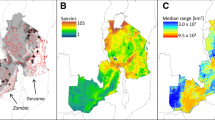Abstract
We investigated whether ranges in continental biota are nested. We propose a test for nested subset structure which can detect nestedness even if there are several sets of nested subsets as expected on a larger geographical scale. The test is based on a Monte Carlo simulation with a null model that considers spatial autocorrelation of the occurrences of a taxon. The number of cases in which the occurrences of a species form a subset of the occurrences of another species is used as test statistic. In a case study we show that the ranges of north-west European land snail species are significantly nested. The geographic centres of the sets of nested subsets correlate with glacial refuges. The differential immigration of taxa restricted to southern refuges during the glacials was probably an important mechanism resulting in the observed nestedness of the ranges of the north-west European land snail species. Some species which were more widespread during Pleistocene glacials contribute little to the nested subset pattern and are not nested among themselves. A comparison between groups of species differing in their dispersal abilities indicates that differences in the degree of nestedness are primarily due to differences in the variance of range sizes and not in dispersal abilities. We found a very weak correlation between dispersal ability and the rank of ranges in the sets of nested subsets indicating that nestedness might in part be caused by differential dispersal abilities. We assume that the graded variation of environmental parameters might be more important in generating the nestedness of ranges of north-west European land snail species than their differential dispersal abilities.





Similar content being viewed by others
References
Atmar W, Patterson BD (1993) The measure of order and disorder in the distribution of species in fragmented habitat. Oecologia 96:373–382
Baur B (1988) Microgeographical variation in shell size of the land snail Chondrina clienta. Biol J Linn Soc 35:247–259
Cook RR, Quinn JF (1995) The influence of colonization in nested species subsets. Oecologia 102:413–424
Cook RR, Quinn JF (1998) An evaluation of randomization models for nested species subsets analysis. Oecologia 113:584–592
Cormen TH, Leiserson CE, Rivest RL (1990) Introduction to algorithms. MIT, Cambridge, Mass.
Cutler A (1991) Nested faunas and extinction in fragmented habitats. Conserv Biol 5:496–505
Darlington PJ Jr (1957) Zoogeography: the geographical distribution of animals. Wiley, New York
Daubenmire R (1975) Floristic plant geography of eastern Washington and northern Idaho. J Biogeogr 2:1–18
Davison AC, Hinkley DV (1997) Bootstrap methods and their application. Cambridge University Press, Cambridge
Dörge N, Walther C, Beinlich B, Plachter H (1999) The significance of passive transport for dispersal in terrestrial snails (Gastropoda, Pulmonata). Z Ökol Natursch 8:1–10
Hausdorf B (2000) Biogeography of the Limacoidea sensu lato (Gastropoda: Stylommatophora): vicariance events and long-distance dispersal. J Biogeogr 27:379–390
Hausdorf B (2002) Units in biogeography. Syst Biol 51:648–651
Hecnar SJ, M'Closkey RT (1997) Patterns of nestedness and species association in a pond-dwelling amphibian fauna. Oikos 80:371–381
Hultén E (1937) Outline of the history of Arctic and Boreal biota during the Quaternary period. Thule, Stockholm
Huntley B, Birks HJB (1983) An atlas of past and present pollen maps for Europe: 0–13,000 years ago. Cambridge University Press, Cambridge
Jaeckel SGA (1962) Ergänzungen und Berichtigungen zum rezenten und quartären Vorkommen der mitteleuropäischen Mollusken. In: Brohmer P, Ehrmann P, Ulmer G (eds) Die Tierwelt Mitteleuropas. 2 (1, Erg.). Quelle and Meyer, Leipzig, pp 25–294
Kadmon R (1995) Nested species subsets and geographic isolation: a case study. Ecology 76:458–465
Kerney MP, Cameron RAD, Jungbluth JH (1983) Die Landschnecken Nord- und Mitteleuropas. Parey, Hamburg
Legendre P (1993) Spatial autocorrelation: trouble or new paradigm? Ecology 74:1659–1673
Lomolino MV (1996) Investigating causality of nestedness of insular communities: selective immigrations or extinctions? J Biogeogr 23:699–703
Ložek V (1964) Quartärmollusken der Tschechoslowakei. Rozpr Ústřed Ústavu Geol 31:1–374, 32 plates
Palmer MW, van der Maarel E (1995) Variance in species richness, species association, and niche limitation. Oikos 73:203–213
Patterson BD, Atmar W (1986) Nested subsets and the structure of insular mammalian faunas and archipelagos. Biol J Linn Soc 28:65–82
Patterson BD, Brown JH (1991) Regionally nested patterns of species composition in granivorous rodent assemblages. J Biogeogr 18:395–402
Roxburgh SH, Chesson P (1998) A new method for detecting species associations with spatially autocorrelated data. Ecology 79:2180–2192
Roxburgh SH, Matsuki M (1999) The statistical validation of null models used in spatial association analyses. Oikos 85:68–78
Ryti RT, Gilpin ME (1987) The comparative analysis of species occurrence patterns on archipelagos. Oecologia 73:282–287
Schilthuizen M, Lombaerts M (1994) Population structure and levels of gene flow in the Mediterranean land snail Albinaria corrugata (Pulmonata: Clausiliidae). Evolution 48:577–586
Simberloff D, Martin J-L (1991) Nestedness of insular avifaunas: simple summary statistics masking complex species patterns. Ornis Fenn 68:178–192
Watkins AJ, Wilson JB (1992) Fine-scale community structure of lawns. J. Ecol 80:15–24
Welter-Schultes FW (1998) Human-dispersed land snails in Crete, with special reference to Albinaria (Gastropoda: Clausiliidae). Biol Gallo-Hell 24:83–106
Wright DH, Reeves JH (1992) On the meaning and measurement of nestedness of species assemblages. Oecologia 92:416–428
Wright DH, Patterson BD, Mikkelson GM, Cutler A, Atmar W (1998) A comparative analysis of nested subset patterns of species composition. Oecologia 113:1–20
Acknowledgements
We are grateful to M. Hausdorf for compiling the distribution data matrix and to M. Hingston for correcting the English.
Author information
Authors and Affiliations
Corresponding author
Rights and permissions
About this article
Cite this article
Hausdorf, B., Hennig, C. Nestedness of north-west European land snail ranges as a consequence of differential immigration from Pleistocene glacial refuges. Oecologia 135, 102–109 (2003). https://doi.org/10.1007/s00442-002-1142-y
Received:
Accepted:
Published:
Issue Date:
DOI: https://doi.org/10.1007/s00442-002-1142-y




